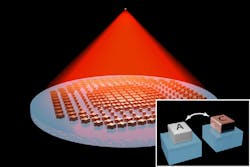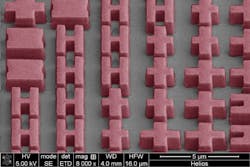Researchers at the Massachusetts Institute of Technology have devised a tunable “lens” that can adjust its focal length without changing its position or shape or moving any components. The lens (called a metalens) is made not of glass, like most optics are, but of a transparent “phase-changing” material. It rearranges its atomic structure when heated to change the way it interacts with light.
The researchers etched the material’s surface with precisely patterned structures that acts as a “metasurface” to refract or reflect light. As the material’s property changes, the optical characteristics of its surface varies accordingly. With the MIT “metalens,” the metasurface focuses light to generate sharp images of objects at a certain distance when at room temperature. But when once heated, its atomic structure changes and the metasurface redirects light to focus on more distant objects.
The design, which currently images within the infrared band, may lead to smaller, less-complex optical devices such as miniature heat scopes for drones, ultracompact thermal cameras for cellphones and low-profile night-vision goggles.
The new lens is made of a phase-changing material the team fabricated by tweaking a material commonly used in rewritable CDs and DVDs. Called GST, it made of germanium, antimony and tellurium, and its internal structure changes when heated with laser pulses. This lets the material switch between transparent and opaque states—the same mechanism that lets data stored on CDs be written, wiped away and rewritten.
Earlier this year, the team added another element, selenium, to GST to make a new phase-changing material: GSST. When the researchers heated the new material, its atomic structure shifted from an amorphous, random tangle of atoms to a more ordered, crystalline structure. This phase shift also changed how infrared light travels through the material, affecting the material’s refracting power but with little change to its transparency.
The team wondered whether GSST’s switching ability could be tailored to direct and focus light at specific points depending on its phase. The material then could serve as an active lens, without the need for mechanical parts to shift focus.
“In general, when making an optical device, it’s challenging to tune its characteristics after it is built,” says Mikhail Shalaginov, a professor at MIT. “Having one like these metalens is like the holy grail for optical engineers. It can change it focus efficiently and over a large range with no moving parts.”
In its new study, the MIT team made a 1-micron-thick layer of GSST and turned it into a “metasurface” by etching microscopic structures of various shapes that refract light in different ways into the GSST layer. The pattern is based on what the researchers know of the materials’ behavior; it lets the surface focus light in one way in its amorphous state and in another way when crystalline.
The researchers tested the new metalens by placing it on a stage and illuminating it with a laser beam tuned to the infrared band of light. At certain distances in front of the lens, they placed transparent objects composed of double-sided patterns of horizontal and vertical bars, known as resolution charts, that are typically used to test optical devices.
The lens, in its initial, amorphous state, produced a sharp image of the first pattern. The team heated the lens to transform the material to its crystalline phase. After the transition, and with the heating source removed, the lens produced an equally sharp image—this time of a second, farther set of bars. This proved it could image at two different depths without moving any parts.
The researchers predict that a metalens with built-in microheaters that quickly heat the material with millisecond pulses could led to continuous focal tuning.


